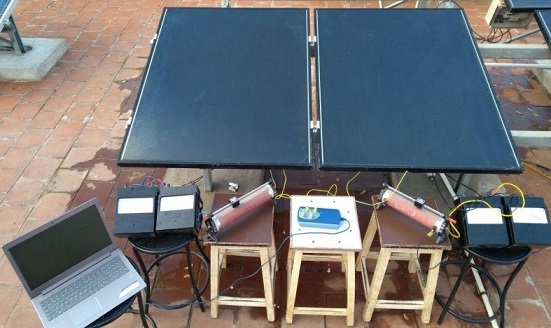A special phase change material, CaCl2.6H2O–Fe3Cl2.6H2O eutectic, could be used for temperature regulation and the passive cooling of PV panels, according to a group of Indian researchers.
Phase change materials (PCMs) are substances capable of storing thermal energy, allowing for the stabilization of temperature. They can absorb or release large amounts of so-called ‘latent’ heat when they go through a change in their physical state, like during the melting and freezing process, for example.
The scientists, from India’s KPR Institute of Engineering and Technology and the National Engineering College, sought to regulate the temperature of copper, indium and selenium (CIS) solar modules through an experimental setup and simulation heat extraction with the use of the Ansys engineering simulation and 3D design software. For the experiment, they used two SF170-S panels from Japanese specialist Solar Frontier.
Encapsulation chamber
The researchers incorporated the CaCl2.6H2O–Fe3Cl2.6H2O inorganic salt in the thin films of the panel and tested the thermal performance in a real outdoor environment.

The substance used is said to have high latent heat of fusion, chemical, nonreactiveness, environment friendliness, nontoxicity, and low cost. “The PCM is encapsulated in the back side of the CIS PV panel, and the encapsulation consists of 11 compartments to minimize the accumulation of PCM salts on one side,” the group explained.
The wall of the encapsulation chamber was made of flexible poly glass, while the PCM was incorporated between the tedlar backsheet solar panel and the tedlar sheet to encapsulate the chamber itself. An inert gel of anabond was used to fix the poly glass and tedlar in the chamber.
“The integration of the PCM on the rear side of the PV cell has more heat transfer rate than the conventional integration in the back surface of the module,” the scientists stated.
Tests

The experiment was conducted in May 2019 with high ambient temperatures and solar radiation to ensure the module temperature rose to the required level, the researchers saud. The two CIS PV panels were modeled using Solid works 16 software.
The results of the PV module with the PCM were compared with those of a reference model without the addition of the PCM. During the simulation, the panel without the PCM reached a peak temperature of about 63 C, while the panel with PCM reached 54 C.
According to the group, the experiment has shown that the inorganic salt absorbs the adequate amount of latent heat. “The results from the study will promote the PV PCM in the community buildings,” it concluded.
The researchers presented their findings in Performance enhancement of copper indium diselenide photovoltaic module using inorganic phase change material, published in the Asia-Pacific Journal of Chemical Engineering.






